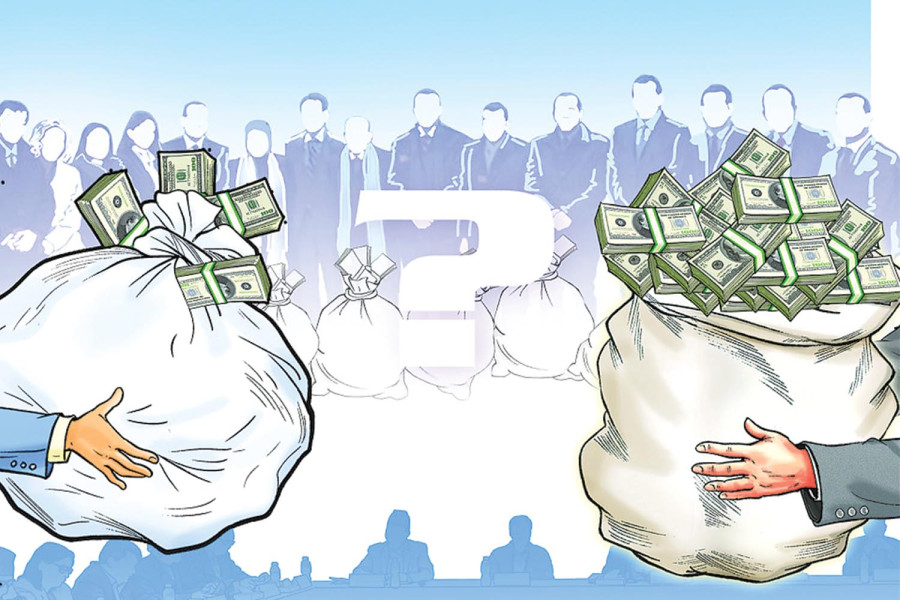Columns
Perils of debt-financed fiscal deficit
For developing countries with growing financing needs, well-managed debt can enable growth.
Bigyan Babu Regmi
Nepal’s budget deficit has significantly increased since the 2015 earthquake due to reconstruction needs. Deficits persisted even during the Covid-19 pandemic. In the past five fiscal years, fiscal shortfalls, largely financed by domestic and foreign borrowing, have hovered between 25 to 30 percent of the total budget, compared to 15 to 20 percent in years before the earthquake. Despite the need to tame the gap, election-motivated public spending, short-tenured governments and impulsive resource allocation continue to cause inflated budgets and imprudent fiscal deficits.
With an estimated borrowing of almost 50 percent higher than the projected capital expenditure, escalating the debt burden is counter-productive. Especially in an environment where revenue mobilisation and capital expenditure are not performing well, a debt-financed (hefty) deficit could only deepen long-run fiscal woes.
Rising debt burden
In the aftermath of the debt crises in Sri Lanka and Pakistan, concerns arose about whether Nepal would follow suit. Fortunately, Nepal’s debt-to-GDP ratio of 42 percent is not outrageously high yet, and the remittance-backed forex reserve cushions external shocks. Nonetheless, the trend over the last few years signals a cautionary approach for future choices. Nepal’s outstanding debt has more than doubled in the past five years, growing by 135 percent from $7.1 billion in FY 2017-18 to $16.7 billion in FY 2022-23. During the same period, India’s outstanding debt increased by only 47 percent despite its aggressive infrastructural spending. While Nepal’s external debt has an average of 36 years for maturity—a comfortable horizon for the medium-term—hasty borrowing choices now could harm the country’s fiscal health in future.
With a yearly real economic growth rate of below 6 percent and an annual growth in public debt of 20 percent, if the current trend continues, the debt will rise above 60 percent of GDP in the next three to five years. This is concerning as even rapidly growing economies such as Malaysia, Indonesia and Vietnam shy away from raising the debt level beyond 50 percent of GDP. For Nepal, which is struggling to diversify its revenue sources, the increasing debt burden means an unnecessarily large liability for debt financing every year. In times of resource crunch, debt defaulting, or even the risk of it, could impede our access to international lending. On the other hand, rising debt levels can have several unintended consequences in the market. For instance, as the debt level increases, investors become more sensitive to economic vulnerabilities, which can discourage risk-taking behaviour in the private sector. Likewise, the government’s temptation to print money to clear debt obligations can lead to upward pressure on inflation and devaluation of the local currency, harming exports.
Short of debt strategy
It would be unfair to characterise debt per se as an undesirable fiscal instrument. For developing countries with growing financing needs, well-managed debt can enable growth and structural transformation. As a least developed country (LDC), Nepal has access to abundant sources of concessional lending. Making use of such prospects before LDC graduation (due 2026) would also serve the case for debt as a sensible financing instrument in the short term. However, as the share of capital expenditure in the budget continues to shrink (27 percent in FY 2019-20 versus 17 percent in FY 2023-24), whether the tenacious debt aims to generate growth remains a question. Against this backdrop, one can imagine that extensive borrowing is emerging not from rigorous needs assessment but from inertia, if not an obsession, for oversized spending.
Notably, 87 percent of Nepal’s external debt is from multilateral creditors and has an average interest rate of around 1 percent. Based on these statistics, one might argue that Nepal’s debt pile is concessional and the cost of borrowing is trivial to add any worrying pressure on the economy. However, it is worth underscoring that no debt is a free lunch, and albeit the low-interest rate, funding impetuous projects from loans has a high opportunity cost.
While Nepal can still benefit from the pool of concessional loans, it is high time Nepal built a clear, farsighted debt strategy to channel funds into projects with longer lifespans and/or considerable social/economic/environmental benefits. As such, climate-smart infrastructure, energy, and micro, small, and medium enterprises (MSMEs)-centred employment are some areas where the financing gap is high and longer-term development dividends are lucrative.
Diligence and accountability
The United Nations Development Program claims Nepal faces a financing gap of around $6 billion annually in achieving the Sustainable Development Goals (SDGs) by 2030. This shortfall will expand in size and scope when longer-term transition strategies and net-zero commitments are incorporated. A combination of financing instruments, including debt, can narrow this gap. However, with such a shortfall annually, there is an opportunity cost for every rupee spent. So accountability and diligence are necessary to ensure rigorous allocation of funds and maximise the marginal return of investment.
Since inflated budgets are emerging from unrealistic revenue targets, sincerity in government income projections is the first step towards changing status quo. A rigorous analysis of financial accounting data must guide fiscal estimates. Real-time statistics on most macro and micro indicators are readily available to decision-makers. Renouncing these data to create blown-up budgetary projections and bulky borrowing lessens the credibility of fiscal policies.
Nepal’s unfulfilled yearning for rapid economic growth needs a growing domestic income. However, blatantly inflating the figures without developing a proper mechanism for sustainable revenue growth and diversification can only derail our growth targets. Second, evidence-based policy-making will be pivotal to directing more energy into projects that have yielded significant progress/outcome and diagnosing implementation hiccups where progress is lacklustre. Furthermore, change in the budget formulation process is a much-needed reform that can, by and large, address issues pertaining to accountability and transparency. Giving a longer time for pre-budget discussion and preparation of plans and policies can enable wider ownership among stakeholders.
Extensive discourse and scrutiny of fiscal choices can also gradually make accountability and diligence intrinsic to the process. After all, the goal is to build institutional capacity and procedural rigour, where fiscal policies materialise from evidence-led explorations, not from the wishful judgements of a “social planner". Restoring credibility in policies through more diligence throughout the process gives rise to needs-driven spending/deficit and targeted debt.
Better strategy
The lure of reaping short-term political dividends has led to impulsive fiscal choices in Nepal. Inertia for expansionary budgets has given rise to a growing deficit. The absence of a long-term debt strategy and alternative financing instruments has increased the reliance on domestic and foreign loans. Consequently, Nepal’s outstanding debt has surged by 135 percent in the last five years, much higher than its neighbours, such as India. Uninterrupted, this trend will raise the debt to an unsustainable level and can have unintended consequences across growth stimulators in the public and private sectors. To accelerate debt-enhanced-development, Nepal needs to develop a prudent debt strategy and explore avenues for concessional and climate-related financing. Amid a shrinking base for revenue and underperformance of capital expenditure, there should be accountability and due diligence for every rupee spent. Embracing evidence-based policy-making and nurturing institutional rigour will spur needs-based resource allocation and targeted borrowing.




 8.12°C Kathmandu
8.12°C Kathmandu















